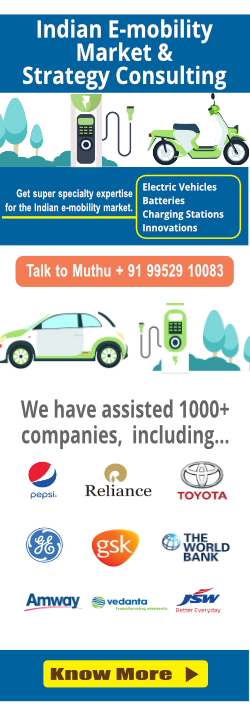![]() This post is a part of BioBiz’s Bio-CNG Perspectives.
This post is a part of BioBiz’s Bio-CNG Perspectives.
BioBiz, a division of EAI, is a leading market intelligence & strategic consulting firm for the Indian bio-based sectors.
This blog post uses the terms bio-CNG and renewable natural gas (RNG) interchangeably.
Bio-CNG or bio-compressed natural gas, also known as sustainable natural gas or biomethane, is a biogas which has been upgraded to a quality similar to fossil natural gas and having a methane concentration of 90% or greater. As the gas is derived from natural and renewable sources, it is also termed renewable natural gas (RNG).
Introduction
Logistics is a critical factor to consider while setting up renewable natural gas projects. This is because a major part of the operations involve transport of waste materials which are procured at cheaper costs (less than Rs. 2/kg). These waste materials are to be transported several kilometres (minimum 15-20 kms) to the plant. As the cost of logistics depend on the total quantum of product and distance transported and not based on the nature of product, location of the plant and the type of vehicles and business models followed can significantly contribute to the economics of the project.
It is hence essential for early movers to explore various logistics practices in the industry and adopt best of breed practices to have an early mover advantage. This blog post provides highlights on some of the best of breed practices observed in India for this nascent sector.
Best of breed practices in the RNG logistics sector
Some of the best of breed practices that have been observed in India for this nascent sector can be categorized under the following headings:
- Feedstock handling at the source of waste
- Transport of waste feedstock to the plant
- Storage of waste feedstock at the plant
- Storage / inventory of the RNG filled cylinders / cascades at the plant
- Outbound logistics / transport of RNG to customers
Highlights of best of breed practices for each of the above:
1. Feedstock handling at the source of waste
- Equipment for storage, collection – For commercial waste, some companies offer solutions such as smart bins for storage of waste at the hotels and restaurants. These are collected by the companies using their own logistics
- Frequency of collection – Most feedstocks such as commercial wastes is collected on a daily basis. Feedstocks such as poultry litter are collected twice a week and those such as press mud and paddy straw are seasonal
- Any mechanical processing of waste possible at source – These may include use of equipments for segregation of waste, size reduction and compaction
- Assisting the waste generator in segregation prior to transport – This method is carried out for commercial waste by waste management companies such as Saahas Zero Waste
2. Transport of waste feedstock to the plant
- Hub and spoke – The model is being followed especially for commercial waste owing to the need to approach large number of sources
- Owned or third party logistics – Depending on the plant location and nature of feedstock, the current RNG manufacturing companies follow either owned or third party logistics model
- Use of IT and related like IoT, cloud, AI etc. to make logistics smart – These technologies can be used for real time tracking of the vehicles to ensure supply of feedstock and delivery of cylinders on time
- Size and type of vehicles (including fuel used) – Some RNG producing companies who have their own logistics use part of the RNG produced as a fuel for the vehicle
- Technology/equipment used in vehicles to optimize feedstock characteristics (compression, etc.) – These include equipment for size reduction of wastes in the vehicles which has dual advantages – partial pre-processing for the AD process as well as space to carry more quantum of wastes
- Avenues to increase capacity utilization – These may include techniques like proper segregation, compaction and similar technologies to increase the capacity utilization of the vehicle
3. Storage of waste feedstock at the plant
- Just in time inventory – Most companies do not have a storage area for feedstock except in the case of press mud and paddy straw to avoid political issues
- Storage environment (type of enclosure etc) – These may include maintaining negative air or proper ventilation mechanism for the feedstock storage area
- Equipment and technologies for storage – These comprise large storage tanks for liquid waste storage and proper enclosed, well-ventilated areas for storage of solid waste such as press mud, manure or agro waste
- Optimal avenues for segregation prior to or during storage – They include having an enclosed room with biofilters for removing impurities, where using mechanical processes, segregation can be carried out. Segregation can also be carried out in a conveyor belt for solid wastes using appropriate technologies depending on the type of waste
4. Storage / inventory of the RNG filled cylinders and cascades at the plant
- Types of cylinders – While type I and II cylinders are commonly in use for CNG / RNG packaging, some companies are trying out type III and IV composite cylinders which are more lighter in terms of weight
- Size of cylinders – Storage of RNG at the production plant is carried out in large tanks of any of the above mentioned cascade types fitted with valves, pipelines and monitoring systems. When in need, the gas can be easily filled in smaller cylinders without the need for any further pressure and sold.
- Cascade equipment technology – Some companies use fabricated cascade equipment technology to ease the challenges in product offtake depending on demand. Cascades made of metal without any covering are the commonly used ones and are affordable
- Number of cylinders / cylinder inventory management – Some companies have an inventory of 10-15 cylinders at the storage facility to cater to immediate customer needs. It is to be noted that in a 50 kg cylinder, 9 kg of RNG can be stored
5. Outbound logistics / transport of RNG to customers
- Types of vehicles used – Depending on the number of customers, their requirements and size of cylinders, a medium to large sized truck could be used to supply the cylinders. Additional space could be left to prevent any hazards from rubbing
- Frequency and schedule of outbound logistics – RNG producing companies could schedule the outbound logistics once in three days for an industrial or commercial sector and for transport sector on a daily basis
- Safety equipment etc – Vents could be provided with the cylinders to prevent any pressure on the caps of cylinders, thus preventing any leakage or explosion
- Type of packaging of cylinders in vehicles – Cylinders could be packed in a box or crate with the valves closed tightly to prevent any leakage and loaded on to the vehicles
It could be observed that through appropriate business partnerships with leading solution providers across the value chain, an early mover could adopt best of breed practices to implement a successful RNG plant in India.
Know more on how BioBiz can assist your business in your strategy for the bio-based businesses, Here








